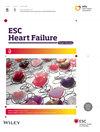Identification, characterisation and outcomes of pre-atrial fibrillation in heart failure with reduced ejection fraction
Abstract
Aims
Atrial fibrillation (AF) in heart failure with reduced ejection fraction (HFrEF) has prognostic implications. Using a machine learning algorithm (FIND-AF), we aimed to explore clinical events and the cardiac magnetic resonance (CMR) characteristics of the pre-AF phenotype in HFrEF.
Methods and results
A cohort of individuals aged ≥18 years with HFrEF without AF from the MATCH 1 and MATCH 2 studies (2018–2024) stratified by FIND-AF score. All received cardiac magnetic resonance using Cvi42 software for volumetric and T1/T2. The primary outcome was time to a composite of MACE inclusive of heart failure hospitalisation, myocardial infarction, stroke and all-cause mortality. Secondary outcomes included the association between CMR findings and FIND-AF score. Of 385 patients [mean age 61.7 (12.6) years, 39.0% women] with a median 2.5 years follow-up, the primary outcome occurred in 58 (30.2%) patients in the high FIND-AF risk group and 23 (11.9%) in the low FIND-AF risk group (hazard ratio 3.25, 95% CI 2.00–5.28, P < 0.001). Higher FIND-AF score was associated with higher indexed left ventricular mass (β = 4.7, 95% CI 0.5–8.9), indexed left atrial volume (β = 5.9, 95% CI 2.2–9.6), higher indexed left ventricular end-diastolic volume (β = 9.55, 95% CI 1.37–17.74, P = 0.022), native T1 signal (β = 18.0, 95% CI 7.0–29.1) and extracellular volume (β = 1.6, 95% CI 0.6–2.5).
Conclusions
A pre-AF HFrEF subgroup with distinct CMR characteristics and poor prognosis may be identified, potentially guiding interventions to reduce clinical events.


 求助内容:
求助内容: 应助结果提醒方式:
应助结果提醒方式:


